Game Review
by David Cabrera,Dengeki Bunko Fighting Climax
Playstation 3 / Vita
| Description: |  |
||
For the 20th anniversary of Dengeki's light novel line, French Bread brings the characters together into a 2D fighting game, with some guest appearances by overbearing dad Sega. |
|||
| Review: | |||
This is a funny situation for French Bread. As one of the stars of the late 90s-early 00's doujinshi game era, they used to make games like this all the time. The formula is pretty simple: you slap whatever character's popular right now into a fighting game. Back then, as Watanabe Seisakusho, they made the Queen of Hearts games (To Heart), Party's Breaker (Comic Party). Did it matter that these characters were schoolgirls and comics artists rather than street fighters? 'Course not! If anything they're blank slates; you can make any absurd attack you like, usually borrowing liberally from existing games. That's what French Bread did-- why, they made Lilian Fourhand, a Contra-style shooting game, out of Marimite-- and they were the best around at it. They were noticed by Type-Moon (hard to imagine these days, but T-M started out in the doujin game themselves) and eventually went pro thanks to the great success of the Melty Blood series. Anyway, fifteen years later French Bread is making a fighting game starring a cast of wildly popular characters who are also wildly inappropriate choices for a fighting game. The only difference is that now it's an official product: Dengeki Fighting Climax (hereafter DFC). 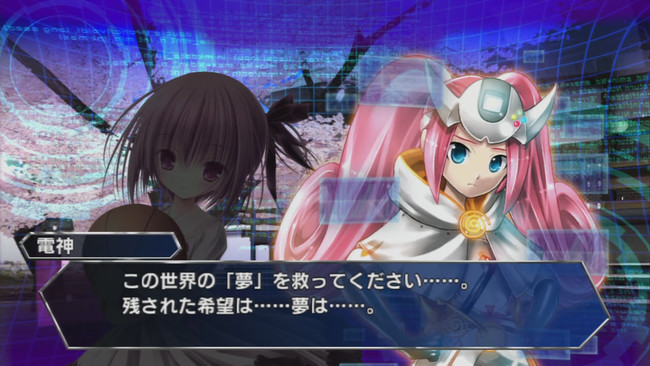 Though it's apparent that this is a French Bread game to anyone who has played their previous Under-Night In-Birth, the developer is not actually credited anywhere apparent in the game. Sega takes all the credit on this one. I personally theorize that they put the whole thing together solely in order to get Sega stuff in front of the eyes of legions of Sword Art Online fans, and perhaps to get those fans' asses into Sega arcades. Sega's presence in this game can be a little overbearing, even for Sega fanboys like myself, but we'll get back to that. You're unlikely to know the name “Dengeki” as a publisher: their novels are rarely translated to English, after all. However, if I rattle off some names-- Oreimo, Durarara, Index-- you might find you recognize a couple. Every character in this game has been animated, at some point: Dengeki and anime have a mutually beneficial relationship. Dengeki has a very wide and deep catalog to choose from: understandably, they chose characters for the game by popularity. Unfortunately, this inadvertently exposes the ages-old trend in otaku media: all but three characters are the main heroines of their particular series, and most fit a particular archetype which has earned the game the sarcastic nickname “Dengeki Waifu Fighter”. 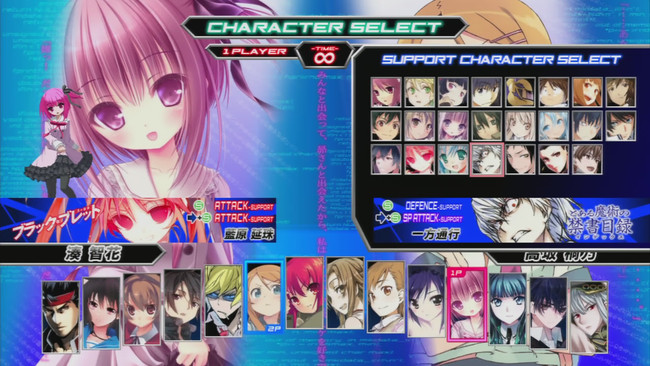 Even if everybody only picks Ken in Street Fighter, or the guy who is just like Ken, fighting games thrive on a varied array of character types; not just the straightforward characters, but the ones so weird you'll never forget them. French Bread's previous original work, Under-Night (hereafter UNIEL), strikes a superb balance of girls, boys, magic-users, monsters and freaks. In character games, players often complain about the unusual choice-- “why is Rocket Racoon in this?!”, they cried-- but these outliers really make the whole affair more lively for everyone. Here, not so much. All “Main Girl” moe wife, all the way. If we were just going to draw from teen anime archetype, then this game needed some “secondary girls,” some “wacky best friends”, and at least one villain! But the popularity polls win, when you have this many “my wife”s in one lineup. 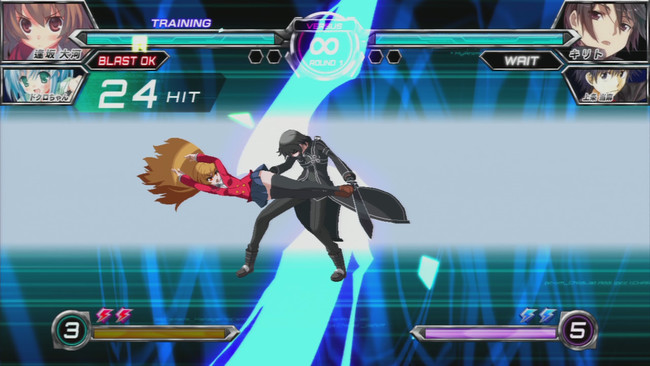 It's a dull roster, which makes it even more noticeable that a pile of more varied and interesting characters (Celty! Kino! Horo! Dokuro-chan?!) are buried in the back of the game as assist characters. Many of the assists show more character in their battle cries, and their two attack animations, than some of the full-fledged characters do in their entire move set. This is a beginner game, so character types are very basic: “close-range rush character”, “long-range projectile character”, and those that have a little of both. If you want to play a grappler character, you're out of luck. The most interesting and entertaining characters are by far those who aren't “fighters”: French Bread has to make up moves for, say, Kirino-- she does battle with cosplay and otaku nonsense-- and they have fun with it. Tomoka from Ro-Kyu-Bu, who fights using her whole team and the known devastating power of b-ball, is in fact inspired. By contrast, characters like Asuna and Miyuki are dead dull. The game is pretty in screenshots, but the animation is another story. When you put it next to French Bread's previous game, there's a huge gap in fluidity of movement. It doesn't have the same eye for detail as UNIEL, actions use as few frames of animation as is humanly possible, and in particular the super moves are parades of animation reuse. The vending machine that Shizuo throws and the one that Mikoto busts with a kick are the same vending machine... and so on. You can tell from the visuals that yes, it had to look nice, but there wasn't going to be any extra love put in it either. The look (and perhaps the overall feel) is noticeably similar to French Bread's old doujin efforts, which were unbelievable in the context of fan work, but just under pro level. In that case, let's all look forward to Melty Blood HD. I just said DFC was a beginner's game, a point which I cannot overstate. If you asked French Bread what a fighting game ought to be like, they'd give you Under-Night. If you asked them “what would be good for a newbie?” they'd give you DFC. The game looks at everything that Persona 4 Arena did to make the genre a little easier, and turns the knob the rest of the way down. 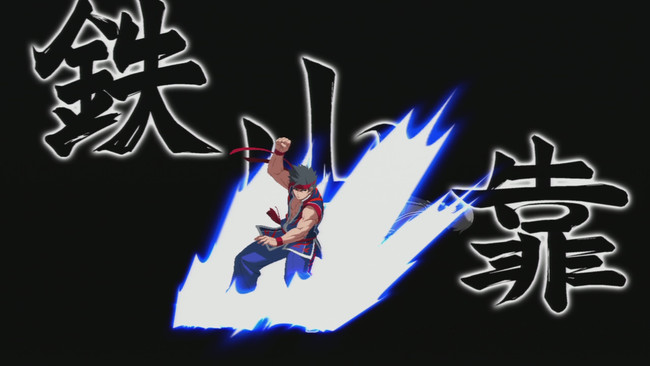 Special moves for all characters share the same motions, all either two buttons at the same time or the classical Street Fighter “fireball” motion. Once you know the moves for one character, you roughly know how to do every special move for every character in the game. There is little to memorize, and nothing that someone who's played Street Fighter doesn't know how to do. Furthermore, the game basically does combos for you. Tap A repeatedly and you'll get a full string of attacks. This isn't like in Persona 4 Arena, where the beginner gets a weak and inefficient combo to get them started learning combos: tapping A just gives you a strong basic combo, with the caveat that you'll be in trouble if the enemy blocks. This puts the beginner in the game right away; they're not doing tiny chips of damage because they don't know a decent combo. The combo system-- should you choose to actually challenge it-- is not that difficult compared to, say, Blazblue, but there is some depth to be squeezed out. 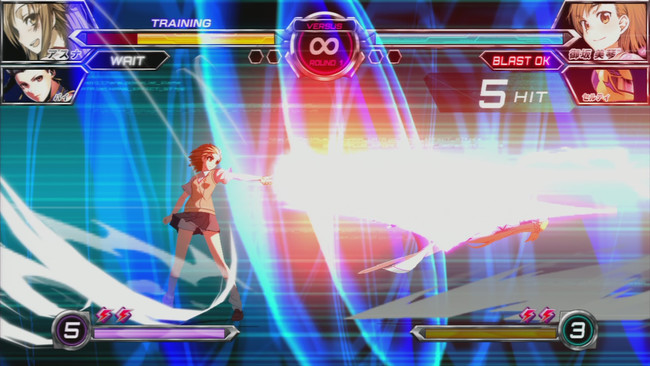 On top of the friendly combo system, there are a huge amount of invincible attacks (3 per character!) that players can mash to get out of trouble. One, the “trump card”, can take about a third of the opponent's life instantly for most characters. So, cynically speaking, there are a lot of systems here for the player who just mashes the buttons as hard as they can. If two players sit down and just start mashing buttons indiscriminately, one is going to almost immediately use a gigantic attack and do major damage to the other player. DFC is a pretty easy game to play. I mentioned that in this game, Sega is kind of an overbearing old guy who really hopes you'll think he's cool. Take, for example, the backgrounds. They appear generic, but they're actually Sega game backgrounds in disguise. The temple is the Virtua Fighter stage, the sci-fi lobby is from Phantasy Star Online 2. A Japanese mansion is Shinobi, because Joe Musashi has probably been in that place. A lot of the games being referenced haven't been seen outside of Japan (Border Break, 7th Dragon, Phantasy Star Online 2), which makes them particularly hard to notice and says something a little unflattering about Sega Japan games in the West lately. The weird thing about the backgrounds is that it's not just a single conspicuous guest appearance like the Sonic stage, it's every background in the entire game. Are Sega trying to say that there isn't a single engaging setting in twenty years of Dengeki books, in all these fantasy stories? I love Sega, I play Akira in this game, and I grinned ear-to-ear at the NiGHTS stage... but it seems a bit much, to the point where Dengeki is costarring with Sega in Dengeki's game. The hidden characters are also Sega, and they're great choices: Selvaria from Valkyria Chronicles and Akira from Virtua Fighter. Selvaria's a big girl, and light novel heroines are tiny, so she absolutely towers over everybody who isn't Shizuo. Coming from a war game, Selvaria is packing heavy weaponry and is probably the game's closest thing to a “heavy”. 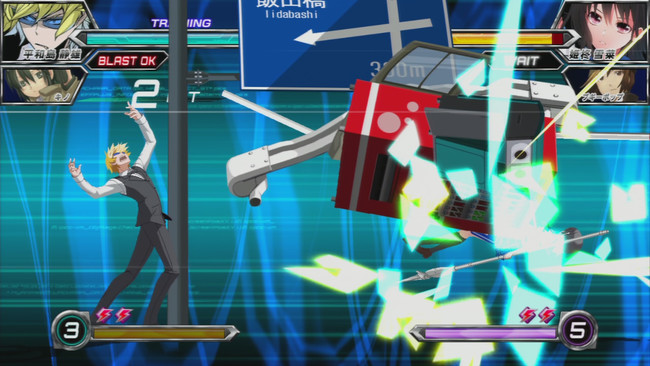 Akira is a really interesting case for genre fans: French Bread have adapted this 3D fighting character to a 2D fighting world, and he still feels like himself. All Akira's moves come from his original game, and his gameplan is basically the same: fast, direct, precise and powerful strikes. In exchange, his mobility suffers greatly. (Use a long-range assist). There isn't a proper “story mode”-- the mode labeled “story” in this game is just a normal arcade mode with an insipid story even for the genre (and this season's breakout anime star, Dreamcast-chan). There is, however, “Dream Duel”, which is closer to what a fan would want from this game. In Dream Duel, you can pick a character you want to play as, pick a character you want to fight against, and-- here's the important part-- they'll have a little chat before the batttle. In this mode, we can learn, for example, that Taiga and Shizuo are basically kindred spirits. (Be aware that all text and voice in this Japanese-release game are in Japanese.) Other modes are straight across from UNIEL-- time attack, survival, character customization-- with a convenience or two strangely removed. Online play quality is excellent at reasonable distances, but there appear to be significantly fewer non-Japanese people playing this game online than with UNIEL. Matches from New York to Japan were playable, but you wouldn't want to do it. If you're a fan of the Dengeki characters, you'll want to look into this game despite the threadbare production values, as FB's design expertise does go a long way. As a “back to basics” anime-style fighting game, it's decent but rough, and clearly in a lower class than the developer's other game. It's no Aquapazza, either. But everybody slept on Aquapazza. Screencaps provided by @botoggle. |
|
The views and opinions expressed in this article are solely those of the author(s) and do not necessarily represent the views of Anime News Network, its employees, owners, or sponsors.
|
| Grade: | |||
Overall : B-
Graphics : C+
Sound/Music : B+
Gameplay : B+
+ Quite a lot of Dengeki heroines (and a few heroes) in one place, approachable system aimed directly at new players, but not boring for experts |
|||
|
discuss this in the forum (59 posts) |
this article has been modified since it was originally posted; see change history |
|||